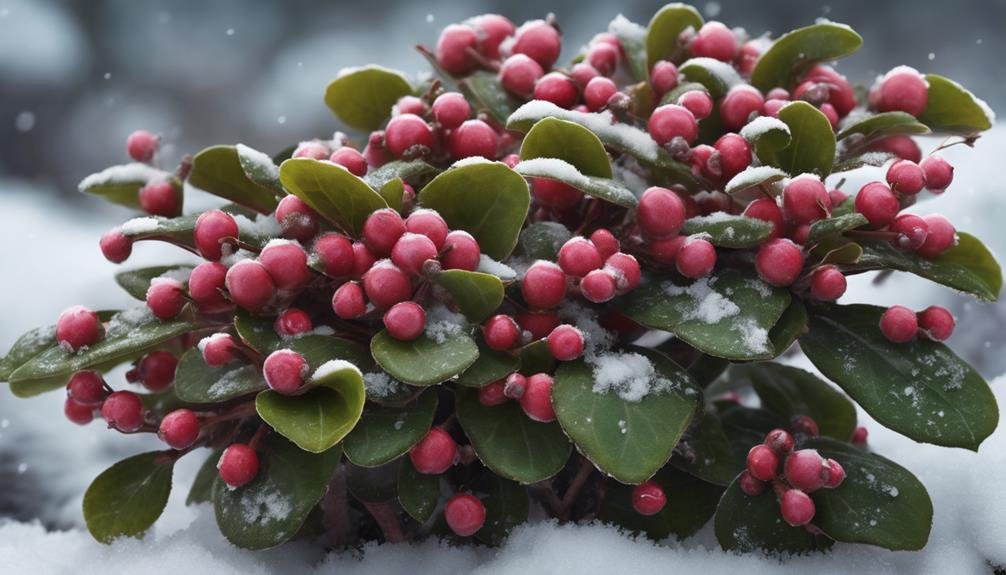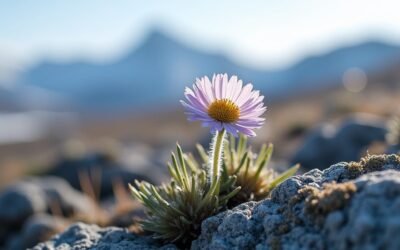Why is Gaultheria Procumbens, also known as Wintergreen, significant in the realm of plants? This question leads us to uncover the intriguing attributes and the ecological importance of this understated yet valuable plant species. Wintergreen is not just another plant; it serves as a resilient inhabitant of the forest floor, flourishing in conditions that might hinder others.
Wintergreen finds its strength in adversity, growing in acidic soils and managing to thrive in shaded areas where sunlight is a precious commodity. This adaptability is not just a testament to its hardiness but also to its key role in ecological balance. It provides a minty aroma that freshens its surroundings, along with visual appeal through its delicate white flowers and vibrant red berries. Beyond its aesthetic contributions, Wintergreen holds traditional medicinal value and offers sustenance to various wildlife, marking it as a plant of multifaceted utility.
The cold hardiness of Wintergreen and its strategies for attracting pollinators remain areas ripe for investigation. These aspects hint at complex adaptive mechanisms and ecological interactions that warrant closer scientific scrutiny. Understanding these mechanisms better could illuminate not just the survival strategies of Wintergreen but also offer insights into forest ecosystem dynamics and plant adaptation strategies.
In summary, Gaultheria Procumbens or Wintergreen emerges as a plant of remarkable resilience and ecological value. Its ability to flourish under challenging conditions, combined with its utility to both humans and wildlife, underscores the importance of this plant in natural and landscaped environments. The exploration of its adaptive mechanisms and pollinator attraction strategies presents an exciting frontier for further research, promising to enrich our knowledge of plant ecology and conservation.
Key Takeaways
Key Takeaways:
- Wintergreen is a resilient, aromatic evergreen that thrives in shaded, acidic soils.
- It plays a crucial role in supporting local wildlife and attracting pollinators.
- Wintergreen is used in traditional medicine, highlighting its versatility.
- It is listed as least concern, indicating a stable population and adaptability.
Wintergreen (Gaultheria Procumbens) is known for its aromatic qualities and evergreen nature, thriving as a groundcover in the shaded, acidic environments of its North American origins. This plant is not only beneficial for local wildlife and pollinators but also holds a special place in traditional medicine practices, showcasing its wide-ranging utility. Despite its extensive use and popularity, Wintergreen remains abundant, classified as least concern, which underlines its resilience and adaptability. Its blend of ecological benefits and aesthetic appeal makes Wintergreen an invaluable asset to landscapes and ecosystems.
Aromatic Groundcover Overview
Wintergreen: A Fragrant Groundcover Marvel
Gaultheria procumbens, known as Wintergreen, stands out in the plant world due to its low growth, glossy leaves, and fragrant characteristics. Thriving in acidic, well-drained soils, this plant showcases its adaptability to particular environmental conditions. Originating from Canada and parts of the United States, Wintergreen’s preference for part to full shade makes it a flexible choice for woodland gardens and shaded areas.
Soil Chemistry and Plant Success
The demand for acidic soil is a pivotal aspect of Wintergreen’s cultivation. This requirement mirrors the common traits of the Ericaceae family, indicating that the plant’s thriving in specific habitats is intimately linked to soil chemistry. The ability to produce small white or pink bell-shaped flowers, followed by bright red edible berries, highlights its ecological role in drawing pollinators and offering food sources within its native range.
Ecosystem Contributions and Ethnobotanical Uses
Wintergreen’s growth habits and environmental preferences shed light on its ecological niche. Its capability to form dense mats that can suppress weeds and stabilize soil shows its functional importance beyond mere visual appeal. The fragrant leaves, which release a distinct wintergreen scent upon being crushed, are rich in aromatic compounds, showcasing the plant’s ethnobotanical benefits.
Evergreen, Low-Growing Shrub
Gaultheria Procumbens: An Understory Gem
The Wintergreen plant, or Gaultheria procumbens, is a marvel of nature that plays a pivotal role in both ecological and ethnobotanical realms. This evergreen shrub isn’t just another plant; it’s a testament to nature’s resilience and beauty, especially in shaded gardens where sunlight is a precious commodity.
A Garden’s Green Carpet
Imagine stepping into a garden and being greeted by a lush, green carpet underfoot. That’s the magic Gaultheria procumbens brings to any landscape. Standing only 3-6 inches tall, this plant isn’t just about its modest height. It’s about how it uses that height to its advantage, forming dense mats that keep unwanted weeds at bay. For anyone aiming for a garden that maintains its elegance with minimal effort, this plant is a peerless choice.
A Feast for the Senses
Beyond its role as a ground cover, Gaultheria procumbens offers a multi-sensory experience. The plant’s leathery leaves aren’t only a visual treat but also a source of a delightful wintergreen scent when crushed. This aromatic offering is thanks to the wintergreen oil within the leaves, a compound prized for its flavoring and medicinal properties. And let’s not overlook the visual spectacle it presents in the summer with its charming, bell-shaped flowers, adding a layer of enchantment to its surroundings.
In essence, Gaultheria procumbens stands out as a sterling example of how plants can serve multiple roles in a garden, from providing year-round visual interest to enriching the sensory experience of the outdoors. Its ability to thrive in the understory of hardwood forests translates well to shaded garden areas, making it a versatile and appealing choice for gardeners and nature lovers alike.
North American Native Range

Origin and Habitat
Wintergreen, a plant celebrated for its beauty and healing abilities, calls the cool, temperate areas of North America its home. Specifically thriving in Canada and the northeastern United States, this species finds solace in the sheltered environments of wooded mountains, making it a staple of forested areas.
Cultural and Medicinal Significance
Known by various names such as Boxberry, Teaberry, and Ground Tea, Gaultheria procumbens has woven itself into the fabric of native cultures. Indigenous tribes of North America harnessed its medicinal qualities for diverse treatments, highlighting the plant’s importance not just in natural ecosystems but also in traditional healing practices.
Aesthetic Appeal in Garden Design
The Heath family member enriches shaded woodland gardens, lending vibrant color and texture throughout the year. Its value in enhancing garden aesthetics is celebrated by the Royal Horticultural Society, illustrating the plant’s significance beyond its native settings and into the realms of garden design.
Pollinator Attraction Mechanisms

Attracting Pollinators with Unique Floral Characteristics
Gaultheria procumbens, also known for its common names American Mountain Tea and Spicy Wintergreen, utilizes its unique botanical features to attract a diverse array of pollinators. The plant is distinguished by its bell-shaped flowers and fragrant leaves, which play a pivotal role in the ecosystem’s pollination processes. Its white and pink flowers, coupled with the aromatic foliage, are irresistible to bees, butterflies, and hummingbirds searching for nectar and pollen. The scent of the leaves, reminiscent of Red Pollom, acts as a natural lure, drawing pollinators toward the plant.
Foliage and Flowers: A Symphony of Attraction
The structure and aroma of wintergreen’s foliage and flowers are central to its ability to allure pollinators. Bell-shaped flowers provide bees and butterflies with an accessible source of nectar and pollen, while the plant’s leaves release a strong, enticing fragrance that attracts a wide variety of pollinating insects. This combination of visual appeal and olfactory stimuli makes Gaultheria procumbens a hub of pollinator activity.
Seed Dispersal and Propagation: The Role of Bright Red Berries
Following the flowering period, wintergreen produces bright red berries, which serve another ecological function: attracting birds. These berries not only continue to support the ecosystem by providing food for avian species but also aid in seed dispersal. As birds consume the berries, they inadvertently assist in the propagation of Gaultheria procumbens, ensuring the survival and spread of this beneficial plant within its habitat.
Least Concern Status

Gaultheria Procumbens: A Flourishing Species of Least Concern
In the realm of botanical conservation, the Gaultheria procumbens stands out as an exemplary species demonstrating resilience and stability in its natural environment. Known commonly as Spring Wintergreen or Canada Tea, this plant has been classified under the Least Concern category, signifying a robust population that faces no immediate threats to its survival.
Adaptability and Ecological Niche
One of the remarkable aspects of Gaultheria procumbens is its exceptional adaptability, allowing it to thrive across diverse habitats. This ability not only ensures the species’ longevity but also underscores its integral role within its ecosystem. The Spring Wintergreen isn’t just surviving; it’s flourishing, contributing to the ecological balance by attracting pollinators and facilitating seed dispersal.
Ornamental Value and Conservation Status
Beyond its ecological contributions, Gaultheria procumbens is also recognized for its ornamental appeal, having been awarded an Award of Garden Merit. This distinction reflects the plant’s aesthetic value and versatility in garden design, further enhancing its status. Despite its secure position, the notion that conservation efforts remain beneficial prevails, supporting biodiversity and ecological integrity.
A Positive Outlook for Gaultheria Procumbens
The future appears bright for Gaultheria procumbens. Its established presence and adaptability suggest that it will continue to be a pivotal species within its habitats. This ensures not only the continuation of its species but also the preservation of the ecological functions it supports, offering both ecological benefits and visual enjoyment to the environments it graces.
Frequently Asked Questions
Does Wintergreen Like Sun or Shade?
Does Wintergreen Prefer Sun or Shade?
Question: What are the preferred growing conditions for Wintergreen, especially regarding sunlight?
Answer: Wintergreen favors shaded areas and thrives in environments that are cool and moist with acidic soil. It requires consistent moisture but minimal care during the winter due to its cold-hardy nature.
How Big Do Wintergreen Gaultheria Get?
Q: How tall and wide does Wintergreen Gaultheria grow?
A: Wintergreen Gaultheria typically reaches a height of 4 to 8 inches and spreads about 6 inches to a foot wide. It requires acidic soil for optimal growth.
Can You Grow Wintergreen in Pots?
Can Wintergreen Be Grown in Pots?
Yes, wintergreen can be successfully grown in pots. It’s important to choose a pot with a 12-inch diameter or larger to accommodate the plant’s root system. The potting mix should be well-draining and highly acidic to meet the plant’s needs. Regular watering during the winter months is also essential to ensure the plant remains hydrated.
Can I Eat Wintergreen Leaves?
Can I eat wintergreen leaves?
Yes, you can consume wintergreen leaves. They are known for their unique flavor and are utilized for various medicinal purposes due to their methyl salicylate content. Their texture also makes them a desirable addition to certain culinary dishes.
Do Diapensia and Wintergreen Thrive in Similar Environments?
Diapensia and wintergreen often thrive in harsh, alpine environments with poor soil and strong winds. Both plants prefer high elevations where conditions are cool and well-drained. The diapensia lapponica plant, in particular, flourishes in rocky, acidic soils, while wintergreen favors moist, shaded areas with slightly richer soil content.
Conclusion
Wintergreen (Gaultheria Procumbens) stands out as an aromatic, evergreen groundcover, cherished for its resilience and ability to flourish in shaded, acidic soils typical of its native North American habitats. This plant not only supports local wildlife and beckons pollinators, but it also enhances the aesthetic appeal of landscapes, making it a favorite among gardeners and landscape architects.
Furthermore, its role in traditional medicine underscores its versatility and enduring value. Despite its popularity and widespread utilization, wintergreen maintains a stable population, classified as least concern, which speaks to its robustness and adaptability.
In summary, wintergreen embodies a remarkable blend of ecological benefits, aesthetic value, and practical utility, making it a significant component of diverse landscapes and ecosystems.


